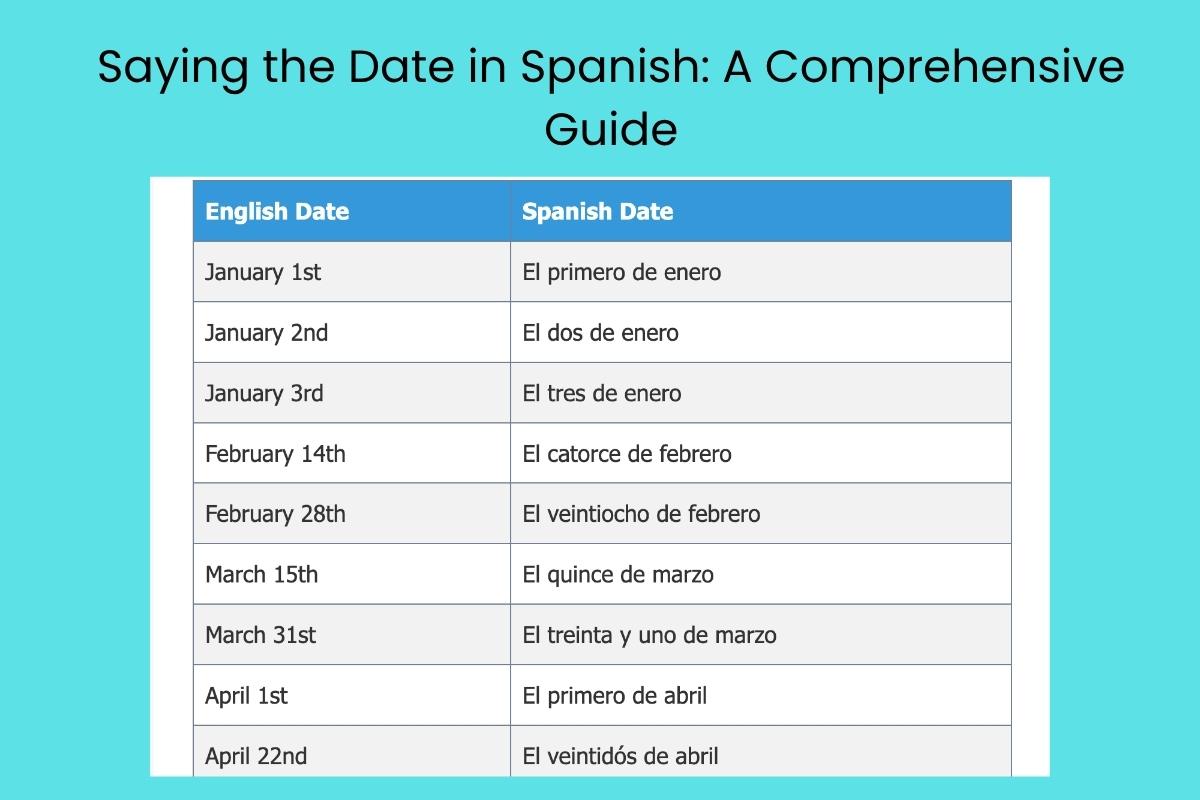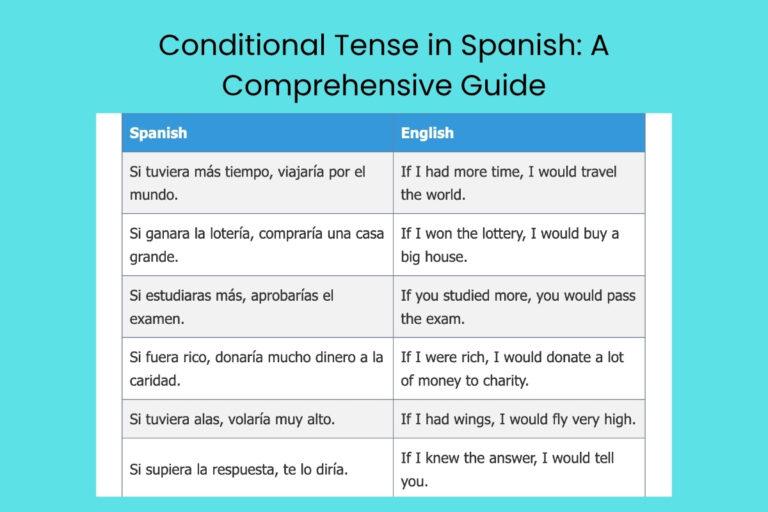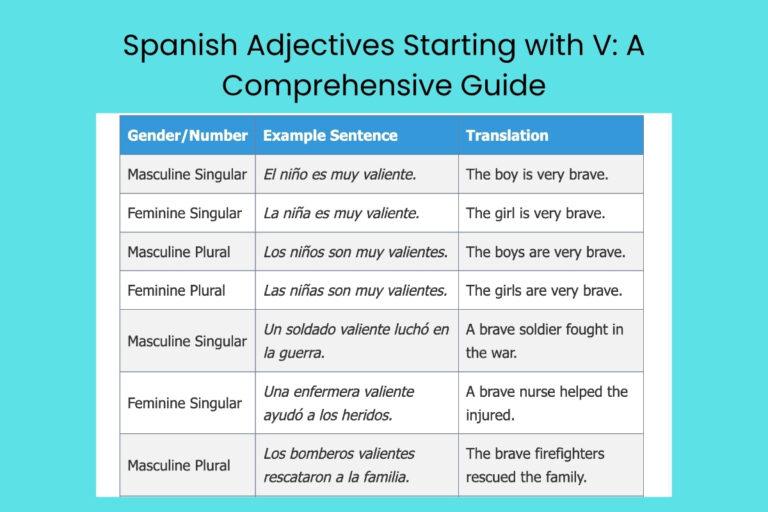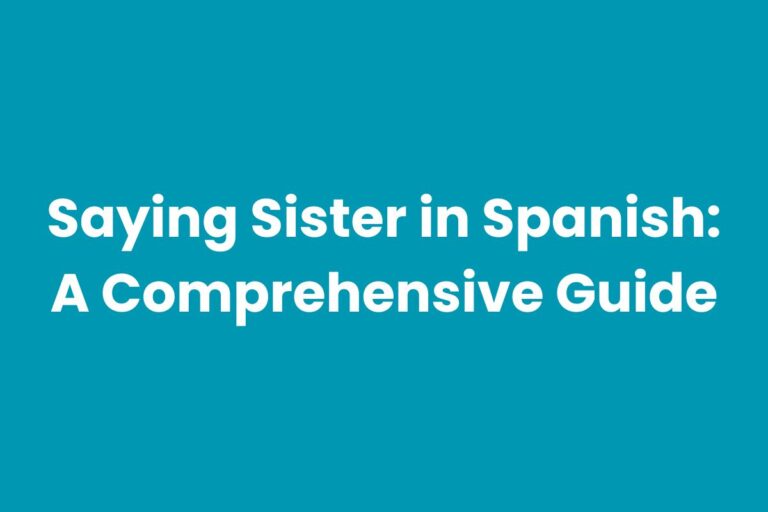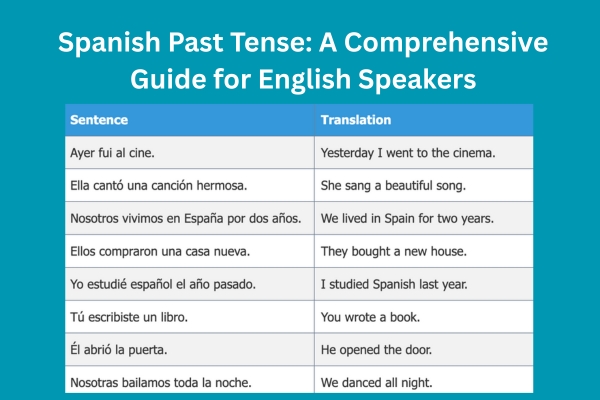Saying the Date in Spanish: A Comprehensive Guide
Mastering how to express dates in Spanish is crucial for effective communication, whether you’re planning a trip, scheduling a meeting, or simply engaging in everyday conversations. This skill extends beyond basic vocabulary; it involves understanding grammatical structures and cultural nuances.
This comprehensive guide is designed for learners of all levels, from beginners to advanced students, providing a clear and structured approach to confidently expressing dates in Spanish.
This guide will equip you with the necessary knowledge and practice to accurately and fluently communicate dates in Spanish. By understanding the rules, common expressions, and potential pitfalls, you’ll enhance your overall language proficiency and cultural awareness.
Whether you’re a student, traveler, or language enthusiast, this resource will serve as a valuable tool in your Spanish language journey.
Table of Contents
- Introduction
- Definition: Expressing Dates in Spanish
- Structural Breakdown
- Types and Categories
- Examples
- Usage Rules
- Common Mistakes
- Practice Exercises
- Advanced Topics
- FAQ
- Conclusion
Definition: Expressing Dates in Spanish
Expressing dates in Spanish involves a specific format and vocabulary. Unlike English, where we often start with the month, Spanish typically begins with the day. The general structure follows the pattern: el + day + de + month + de + year. This structure emphasizes the day as the primary element of the date.
The function of expressing dates is not only to convey temporal information but also to provide context and precision. Knowing how to accurately state a date is essential in formal and informal settings, from writing emails to making appointments.
Furthermore, the way dates are expressed can reflect cultural nuances and regional variations.
In Spanish, dates are always masculine, requiring the use of the definite article “el” before the day. The preposition “de” connects the day, month, and year.
Understanding these basic elements is fundamental to mastering date expressions. This foundation will allow you to build upon more complex structures and variations.
Structural Breakdown
The core structure for expressing dates in Spanish is relatively straightforward but requires attention to detail. Let’s break it down into its components:
- El: The definite article “el” (the) is always used before the day of the month.
- Day: The day of the month is expressed as a cardinal number (uno, dos, tres, etc.).
- De: The preposition “de” (of) connects the day to the month.
- Month: The month is expressed as a noun (enero, febrero, marzo, etc.).
- De: Another preposition “de” connects the month to the year.
- Year: The year is expressed as a cardinal number.
Therefore, the complete structure is: El + day + de + month + de + year. For example, January 1, 2024, would be expressed as “El primero de enero de dos mil veinticuatro.” Note that “primero” (first) is an exception; it’s an ordinal number.
When speaking about a specific day, the article “el” is mandatory. However, when indicating a date range or general period, the article might be omitted.
Understanding these nuances is key to using dates accurately and naturally in Spanish conversation and writing.
The order of elements is crucial. Deviating from the standard structure can lead to confusion or misinterpretation.
Practice with various dates to solidify your understanding of this pattern. This structural understanding forms the basis for expressing more complex date-related information.
Types and Categories
While the basic structure remains consistent, there are slight variations in how dates can be expressed depending on the context. Here are some categories:
Formal Dates
Formal dates are typically used in official documents, letters, and academic writing. They adhere strictly to the standard structure: El + day + de + month + de + year. There is little room for deviation in these contexts.
Informal Dates
Informal dates are used in casual conversations, emails to friends, and less formal settings. While the standard structure is still common, there may be slight variations, such as omitting the “el” in certain contexts.
Historical Dates
Expressing historical dates might involve additional phrases to indicate centuries or specific periods. For example, “en el siglo XVIII” (in the 18th century) can be added to provide historical context.
Date Ranges
Expressing date ranges involves using prepositions like “del” (from) and “al” (to). For example, “del 1 de enero al 31 de diciembre” (from January 1st to December 31st).
These constructs need careful attention to prepositions and article agreement.
Dates with Days of the Week
Including the day of the week adds another layer to date expressions. You would simply add the day of the week before the rest of the date: “El lunes, 1 de enero de 2024” (Monday, January 1st, 2024).
Examples
To solidify your understanding, let’s explore various examples of how to express dates in Spanish. These examples are categorized to cover different scenarios and levels of formality.
Basic Date Examples
These examples demonstrate the fundamental structure of expressing dates in Spanish. They cover a range of days and months to illustrate the pattern.
The table below shows the Spanish translation of basic dates. Each date includes the day and month to show the structure.
| English Date | Spanish Date |
|---|---|
| January 1st | El primero de enero |
| January 2nd | El dos de enero |
| January 3rd | El tres de enero |
| February 14th | El catorce de febrero |
| February 28th | El veintiocho de febrero |
| March 15th | El quince de marzo |
| March 31st | El treinta y uno de marzo |
| April 1st | El primero de abril |
| April 22nd | El veintidós de abril |
| May 5th | El cinco de mayo |
| May 25th | El veinticinco de mayo |
| June 10th | El diez de junio |
| June 30th | El treinta de junio |
| July 4th | El cuatro de julio |
| July 21st | El veintiuno de julio |
| August 8th | El ocho de agosto |
| August 31st | El treinta y uno de agosto |
| September 9th | El nueve de septiembre |
| September 20th | El veinte de septiembre |
| October 1st | El primero de octubre |
| October 31st | El treinta y uno de octubre |
| November 11th | El once de noviembre |
| November 30th | El treinta de noviembre |
| December 12th | El doce de diciembre |
| December 25th | El veinticinco de diciembre |
Year Examples
These examples focus on expressing years in Spanish. Note how years are read as cardinal numbers.
The table below shows the Spanish translation of years. These examples cover a range of years to demonstrate the correct pronunciation and structure.
| English Year | Spanish Year |
|---|---|
| 2000 | Dos mil |
| 2005 | Dos mil cinco |
| 2010 | Dos mil diez |
| 2015 | Dos mil quince |
| 2020 | Dos mil veinte |
| 2021 | Dos mil veintiuno |
| 2022 | Dos mil veintidós |
| 2023 | Dos mil veintitrés |
| 2024 | Dos mil veinticuatro |
| 1990 | Mil novecientos noventa |
| 1999 | Mil novecientos noventa y nueve |
| 1850 | Mil ochocientos cincuenta |
| 1776 | Mil setecientos setenta y seis |
| 1600 | Mil seiscientos |
| 1500 | Mil quinientos |
| 1492 | Mil cuatrocientos noventa y dos |
| 1300 | Mil trescientos |
| 1200 | Mil doscientos |
| 1100 | Mil cien |
| 1066 | Mil sesenta y seis |
| 1000 | Mil |
| 900 | Novecientos |
| 800 | Ochocientos |
| 700 | Setecientos |
| 600 | Seiscientos |
Full Date Examples
These examples combine the day, month, and year to form complete dates in Spanish. They showcase the standard structure in its entirety.
The table below presents full date examples, combining the day, month, and year. This demonstrates the comprehensive structure used in Spanish date formatting.
| English Date | Spanish Date |
|---|---|
| January 1, 2024 | El primero de enero de dos mil veinticuatro |
| February 14, 2023 | El catorce de febrero de dos mil veintitrés |
| March 15, 2022 | El quince de marzo de dos mil veintidós |
| April 22, 2021 | El veintidós de abril de dos mil veintiuno |
| May 5, 2020 | El cinco de mayo de dos mil veinte |
| June 10, 2019 | El diez de junio de dos mil diecinueve |
| July 4, 2018 | El cuatro de julio de dos mil dieciocho |
| August 8, 2017 | El ocho de agosto de dos mil diecisiete |
| September 9, 2016 | El nueve de septiembre de dos mil dieciséis |
| October 31, 2015 | El treinta y uno de octubre de dos mil quince |
| November 11, 2014 | El once de noviembre de dos mil catorce |
| December 25, 2013 | El veinticinco de diciembre de dos mil trece |
| January 2, 2012 | El dos de enero de dos mil doce |
| February 29, 2011 | El veintinueve de febrero de dos mil once |
| March 1, 2010 | El primero de marzo de dos mil diez |
| April 15, 2009 | El quince de abril de dos mil nueve |
| May 20, 2008 | El veinte de mayo de dos mil ocho |
| June 2, 2007 | El dos de junio de dos mil siete |
| July 18, 2006 | El dieciocho de julio de dos mil seis |
| August 3, 2005 | El tres de agosto de dos mil cinco |
Expressing Date Ranges
These examples demonstrate how to express date ranges in Spanish, using prepositions like “del” and “al.”
The table below illustrates how to express date ranges in Spanish. These examples use “del” (from) and “al” (to) to define the periods.
| English Date Range | Spanish Date Range |
|---|---|
| From January 1st to January 31st | Del primero de enero al treinta y uno de enero |
| From February 14th to February 28th | Del catorce de febrero al veintiocho de febrero |
| From March 1st to March 31st | Del primero de marzo al treinta y uno de marzo |
| From April 1st to April 30th | Del primero de abril al treinta de abril |
| From May 5th to May 25th | Del cinco de mayo al veinticinco de mayo |
| From June 10th to June 30th | Del diez de junio al treinta de junio |
| From July 4th to July 21st | Del cuatro de julio al veintiuno de julio |
| From August 8th to August 31st | Del ocho de agosto al treinta y uno de agosto |
| From September 9th to September 20th | Del nueve de septiembre al veinte de septiembre |
| From October 1st to October 31st | Del primero de octubre al treinta y uno de octubre |
| From November 11th to November 30th | Del once de noviembre al treinta de noviembre |
| From December 12th to December 25th | Del doce de diciembre al veinticinco de diciembre |
| From January 1st, 2023 to January 31st, 2023 | Del primero de enero de dos mil veintitrés al treinta y uno de enero de dos mil veintitrés |
| From February 1st, 2023 to March 15th, 2023 | Del primero de febrero de dos mil veintitrés al quince de marzo de dos mil veintitrés |
| From April 10th, 2022 to May 20th, 2022 | Del diez de abril de dos mil veintidós al veinte de mayo de dos mil veintidós |
| From June 5th, 2021 to July 1st, 2021 | Del cinco de junio de dos mil veintiuno al primero de julio de dos mil veintiuno |
| From August 2nd, 2020 to September 30th, 2020 | Del dos de agosto de dos mil veinte al treinta de septiembre de dos mil veinte |
| From October 15th, 2019 to November 10th, 2019 | Del quince de octubre de dos mil diecinueve al diez de noviembre de dos mil diecinueve |
| From December 1st, 2018 to December 31st, 2018 | Del primero de diciembre de dos mil dieciocho al treinta y uno de diciembre de dos mil dieciocho |
Historical Date Examples
These examples show how to express historical dates, often including references to centuries.
The table below provides examples of expressing historical dates in Spanish, incorporating references to centuries and significant periods.
| English Historical Date | Spanish Historical Date |
|---|---|
| July 4, 1776 | El cuatro de julio de mil setecientos setenta y seis |
| The 18th century | El siglo XVIII (dieciocho) |
| The French Revolution (1789-1799) | La Revolución Francesa (de mil setecientos ochenta y nueve a mil setecientos noventa y nueve) |
| The Middle Ages | La Edad Media |
| The Renaissance | El Renacimiento |
| Columbus’ arrival in America (1492) | La llegada de Colón a América (en mil cuatrocientos noventa y dos) |
| World War I (1914-1918) | La Primera Guerra Mundial (de mil novecientos catorce a mil novecientos dieciocho) |
| World War II (1939-1945) | La Segunda Guerra Mundial (de mil novecientos treinta y nueve a mil novecientos cuarenta y cinco) |
| The fall of the Berlin Wall (November 9, 1989) | La caída del Muro de Berlín (el nueve de noviembre de mil novecientos ochenta y nueve) |
| The Roman Empire | El Imperio Romano |
| The Egyptian civilization | La civilización Egipcia |
| The Cold War | La Guerra Fría |
| The Industrial Revolution | La Revolución Industrial |
| The Spanish Civil War (1936-1939) | La Guerra Civil Española (de mil novecientos treinta y seis a mil novecientos treinta y nueve) |
| The discovery of penicillin | El descubrimiento de la penicilina |
| The invention of the printing press | La invención de la imprenta |
| The Enlightenment | La Ilustración |
| The Victorian Era | La Época Victoriana |
Usage Rules
Several rules govern the correct usage of dates in Spanish. Adhering to these rules ensures clarity and accuracy.
- Use of “El”: Always use the definite article “el” before the day of the month, except when expressing a general period or date range.
- Preposition “De”: The preposition “de” is essential for connecting the day, month, and year.
- Ordinal Numbers: Use ordinal numbers only for the first day of the month (primero). For all other days, use cardinal numbers.
- Year Format: Years are read as cardinal numbers. For example, 1995 is “mil novecientos noventa y cinco.”
- Date Order: The order is always day, month, then year.
There are exceptions to these rules. For instance, in some informal contexts, the “el” might be omitted.
However, in formal writing, it’s always required. Also, certain regional dialects may have slight variations, but the standard structure is universally understood.
Pay attention to the context. Formal settings demand strict adherence to the rules, while informal settings allow for more flexibility.
Understanding these nuances will help you communicate dates effectively in various situations.
Common Mistakes
Learners often make common mistakes when expressing dates in Spanish. Being aware of these pitfalls can help you avoid them.
The table below lists common mistakes learners make when expressing dates in Spanish, along with the correct versions. Understanding these errors can help you improve your accuracy and fluency.
| Incorrect | Correct | Explanation |
|---|---|---|
| Uno de enero | El primero de enero | Use “primero” (first) for the first day of the month. |
| El uno de enero | El primero de enero | Again, “primero” is the only ordinal number used. |
| 1 de enero | El primero de enero | Missing the definite article “el.” |
| De enero uno | El primero de enero | Incorrect order of day and month. |
| Enero 1 | El primero de enero | Incorrect order and missing “el” and “de.” |
| Dos mil y veinte | Dos mil veinte | Do not use “y” when stating the year. |
| El cinco de mayo, dos mil veinte. | El cinco de mayo de dos mil veinte. | Missing “de” between month and year. |
| Del uno de enero al treinta y uno enero. | Del primero de enero al treinta y uno de enero. | Use “primero” and include “de” after “uno”. |
| En el siglo dieciocho | En el siglo XVIII | While “dieciocho” is not wrong, using Roman numerals is more common for centuries. |
| La primero de mayo | El primero de mayo | “Primero” needs to agree in gender with “día” (masculine). |
One frequent error is omitting the definite article “el.” Another is using “y” when stating the year. Paying attention to these details will significantly improve your accuracy.
Another common mistake is using ordinal numbers for days other than the first of the month. Remember that only “primero” is an ordinal number in this context.
Cardinal numbers are used for all other days.
Practice Exercises
Test your knowledge with these practice exercises. Translate the following dates into Spanish.
Complete the following table by translating the English dates into Spanish. This will help you practice the correct structure and vocabulary for expressing dates in Spanish.
| English Date | Spanish Date |
|---|---|
| March 1, 2024 | |
| April 15, 2023 | |
| May 20, 2022 | |
| June 2, 2021 | |
| July 18, 2020 | |
| August 3, 2019 | |
| September 7, 2018 | |
| October 12, 2017 | |
| November 22, 2016 | |
| December 31, 2015 |
Answers:
| English Date | Spanish Date |
|---|---|
| March 1, 2024 | El primero de marzo de dos mil veinticuatro |
| April 15, 2023 | El quince de abril de dos mil veintitrés |
| May 20, 2022 | El veinte de mayo de dos mil veintidós |
| June 2, 2021 | El dos de junio de dos mil veintiuno |
| July 18, 2020 | El dieciocho de julio de dos mil veinte |
| August 3, 2019 | El tres de agosto de dos mil diecinueve |
| September 7, 2018 | El siete de septiembre de dos mil dieciocho |
| October 12, 2017 | El doce de octubre de dos mil diecisiete |
| November 22, 2016 | El veintidós de noviembre de dos mil dieciséis |
| December 31, 2015 | El treinta y uno de diciembre de dos mil quince |
Exercise 2:
Translate the following date ranges into Spanish:
| English Date Range | Spanish Date Range |
|---|---|
| From January 5th to January 20th | |
| From February 10th to March 1st | |
| From April 1st to April 30th | |
| From May 15th to June 10th | |
| From July 1st to August 1st |
Answers:
| English Date Range | Spanish Date Range |
|---|---|
| From January 5th to January 20th | Del cinco de enero al veinte de enero |
| From February 10th to March 1st | Del diez de febrero al primero de marzo |
| From April 1st to April 30th | Del primero de abril al treinta de abril |
| From May 15th to June 10th | Del quince de mayo al diez de junio |
| From July 1st to August 1st | Del primero de julio al primero de agosto |
Exercise 3:
Correct the following incorrect dates:
- Uno de enero de dos mil veinte.
- El cinco de mayo, dos mil veinte.
- Del uno de enero al treinta y uno enero.
- La primero de mayo.
Answers:
- El primero de enero de dos mil veinte.
- El cinco de mayo de dos mil veinte.
- Del primero de enero al treinta y uno de enero.
- El primero de mayo.
Advanced Topics
For advanced learners, there are more nuanced aspects of expressing dates in Spanish. These include:
- Regional Variations: Different Spanish-speaking countries may have slight variations in how they express dates. While the standard structure is universally understood, being aware of regional differences can enhance your cultural sensitivity.
- Formal vs. Informal Language: The level of formality can influence the choice of words and structure. Formal settings demand strict adherence to the rules, while informal settings allow for more flexibility.
- Historical Context: When discussing historical events, using specific terminology and phrases can add depth and accuracy to your communication.
Exploring these advanced topics will further refine your ability to express dates in Spanish with precision and cultural awareness. Pay attention to context and audience to tailor your language accordingly.
FAQ
- Why is “el” used before the day of the month?
The definite article “el” is used because dates are considered masculine nouns in Spanish. It’s a grammatical requirement that adds specificity to the date.
- Why is “primero” used for the first day of the month?
“Primero” is an ordinal number meaning “first.” It’s an exception to the rule of using cardinal numbers for all other days of the month.
- Can I omit “el” in informal conversations?
In some informal contexts, omitting “el” is acceptable, but it’s generally safer to include it, especially in formal writing.
- How do I express date ranges?
Use the prepositions “del” (from) and “al” (to) to indicate the start and end dates of the range. For example, “Del 1 de enero al 31 de enero.”
- How do I say the year 2000 in Spanish?
The year 2000 is expressed as “dos mil.” Years are generally read as cardinal numbers.
- What’s the correct order for expressing dates?
The correct order is day, month, then year: “El + day + de + month + de + year.”
- How do I express centuries in Spanish?
Centuries are typically expressed using Roman numerals: “El siglo XVIII” (the 18th century). You can also use the cardinal number, but Roman numerals are more common.
- Are there regional variations in expressing dates?
Yes, there may be slight regional variations, but the standard structure is universally understood. Being aware of these variations can enhance your cultural sensitivity.
- Do I use “y” (and) when saying the year?
No, do not use “y” when stating the year. For example, say “dos mil veinte” instead of “dos mil y veinte.”
- How do I include the day of the week in a date?
Simply add the day of the week before the rest of the date: “El lunes, 1 de enero de 2024” (Monday, January 1st, 2024).
Conclusion
Mastering how to express dates in Spanish is a fundamental skill for effective communication. By understanding the basic structure, usage rules, and common mistakes, you can confidently and accurately convey dates in various contexts.
Remember the
remember the importance of the definite article “el,” the preposition “de,” and the correct order of elements. Practice regularly, and pay attention to the nuances of formal and informal language.
With consistent effort, you’ll enhance your overall Spanish language proficiency and cultural awareness.

